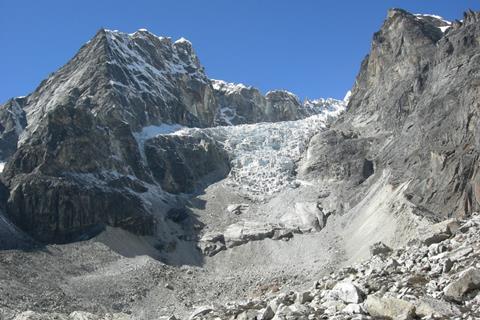Scientists have discovered how topographical irregularities in barren substrates exposed by a melting Himalayan glacier are driving the formation of a variety of pioneering microbial communities that will pave the way for soil formation.

The team, which is investigating the primary colonisation of barren substrates in a moraine released by a Himalayan glacier, discovered that bacterial community assembly is primarily driven by the variable environmental features in a mosaic of micro-niches.
Worldwide, mountain environments are threatened by climate change that causes glacier melting and the release from ice of bare stony substrates. Although poor in nutrients, these substrates are colonized by pioneer microbes able to trigger those changes that will lead to the formation of a soil capable to support plant growth.
The team behind the discovery, from the University of Milan and Bolzano in Italy, KAUST in Saudi Arabia, Edinburgh University in UK and the University of Bremen in Germany, studied the first colonizers of the barren substrates released by the Lobuche glacier in the Nepalese Himalaya at 5050 m a.s.l.
They looked to the so-called “biological soil crusts”, microorganism-based self-organized structures which initiate the accumulation of organic matter in the mineral substrate of the moraine.
The study, published in Environmental Microbiology, an Applied Microbiology International publication, analysed six sites in an area of the moraine where biological soil crusts are formed and identified the factors that steer the assembly of the pioneer bacterial communities.
It was revealed that the composition of the microbial colonizers is influenced by the topographical location and therefore the level of exposure to the different climatic factors such as light and humidity.
“The moraine has an irregular surface with hummocks and hills with variable orientation, altitude and slope. The crusts we investigated were very close each other and their positions recapitulate the irregular topography of the moraine,” said Dr Eleonora Rolli, one of the two co-first authors of the study.
“Due to their position and orientation, the crusts were differently exposed to sunlight irradiance, temperature, humidity, and these environmental factors influenced the composition of the microbes in the crusts,” added the other co-first author, Ramona Marasco.
Pr. Daniele Daffonchio, the senior author of the study, commented: “The irregular topography of the moraine governs the interaction between the environment and the pioneer microbial communities.
“Our study suggests that the diversity of bacteria in the Himalayan moraine can change at microscale dimension under those harsh conditions and this knowledge should be considered to study the process of soil formation.”
‘Environmental micro-niche filtering shapes bacterial pioneer communities during primary colonization of a Himalayas glacier forefield’ was published in Environmental Microbiology on November 3 2022.
Topics
- Applied Microbiology International
- Asia & Oceania
- biological soil crusts
- Climate Action
- Community
- Dr Eleonora Rolli
- glacier
- Healthy Land
- Himalayas
- KAUST
- Lobuche glacier
- Middle East & Africa
- moraine
- Nepal
- pioneer
- Professor Daniele Daffonchio
- Ramona Marasco
- Research
- Research News
- Soil & Plant Science
- soil formation
- UK & Rest of Europe







No comments yet